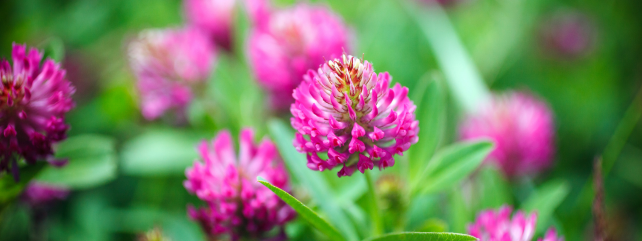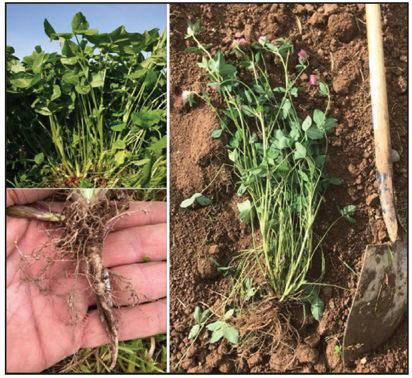19 April 2025
The Benefits of Red Clover

Red clover builds soil fertility and boosts animal performance making it an ideal option for farms looking to cut nitrogen bills and grow top-quality forage.
Red clover is a relatively drought tolerant, deep tap rooting, nitrogen fixing legume that is primarily used for silage production but can also be grazed by cattle or sheep in the autumn. Red clover in a mixture with perennial ryegrass and white clover can produce high yields of multi-cut silage without artificial fertiliser. It also has the capacity to fix atmospheric nitrogen into plant-available N in the soil, supplying the equivalent of around 300 kg per ha per year.
Red clover has a different growth habit to white clover and requires different management to optimise its performance. The crown of the red clover plant acts as the growing point and is located above ground level. The stem grows upwards from the crown. The crown of the plant must be protected from overgrazing or cutting too low in order to maintain red clover in the sward. Red clover is more productive in regions with damper and temperate climates and is highly-productive under Irish conditions.
Uses of red clover
- The main role of red clover is for silage production, although it is often grazed by cattle or sheep after the final silage cut in the autumn.
- Red clover will not persist if continuously grazed or cut more frequently than every 30 days due to a combination of excessive foliage removal and plant crown damage by hoof trampling.
Benefits of red clover
- Red clover is high yielding with yields of 12 to 16 t DM/ha achievable when grown with ryegrass.
- It converts atmospheric Nitrogen into a plant usable form. An annual Nitrogen fixation of 150-200 kg/ha is achievable from swards with a high red clover content.
- Red clover is suitable as a break crop to improve soil structure and fertility and as a supplier of organic matter. It can also be used as a green manure crop. It is particularly valuable for building soil fertility once organic conversion has begun.
- Red clover is relatively drought tolerant due to its deep tap root. It offers superior production to white clover in dry summers.
- It has a high protein content of 16 to 20%. The feeding value of red clover silage is higher than grass silage resulting in greater animal intakes and higher levels of animal performance in terms of milk and protein yields, and liveweight gain.
Results from an experiment conducted at Teagasc Grange found the mean liveweight gain in beef cattle offered different types of silage were:
- Grass silage 0.59 kg/day
- Grass/white clover silage 0.83 kg/day
- Red clover silage 1.04 kg/day
Growth habit of red clover
Red clover produces a number of erect shoots that grow from the crown of a taproot, similar to a dock plant. It has a poor capacity to spread out in the sward or replace shoots that are damaged, which accounts for its short lifespan in swards. In contrast, white clover produces stolons that grow along the surface of the soil in much the same way that ivy grows up a wall. This growth habit accounts for the greater persistence of white clover in swards compared with red clover.
At Teagasc Solohead, after burning off with glyphosate, the ground is prepared with one or two ‘runs’ of a disc harrow followed by two runs of a power harrow. The seed is sown during the second run of the power harrow.

The growth habit of red clover
Sward Management
Red Clover is a relatively short-term ley maintaining high levels of production typically for three-to-six years, it tends to die out of the sward over time.
- Red clover seeding rate – 20 to 22 kg/ha of grass seed plus 7 to 10 kg/ha of red clover seed. White clover can also be added to the mix at a rate of 1 kg/ha if required.
- In the establishment year, red clover should be allowed to flower before harvesting the first cut of silage to help root development and the growth of the bacteria that fix N.
- In subsequent years, silage harvesting should occur at intervals of six to eight weeks, any time between bud development and early flowering.
- Three to four silage cuts can be taken each year. Approximately 80-90% of total annual yield will be obtained from silage cuts completed by late July-early August. The final cut should be taken no later than mid-October.
- In the autumn, herbage should be cut or grazed – ideally in October without poaching, soil compaction and physical damage to the plant crowns.
- Cut silage crops to a residual height of 7-8 cm above ground level.
- Optimum post-grazing sward height is 6 cm.
- Optimum over-wintering sward height is 4-6 cm above ground level.
- Red clover can contain up to 1% oestrogenic compounds. Oestrogen levels can lower ewe fertility. Therefore, do not allow breeding ewes to graze red clover swards or eat red clover silage for a period of 6 weeks before and after mating to avoid any adverse effect of red clover oestrogens on lambing percentage. Store lambs can be offered red clover swards and silage at any time.
- In terms of grazing, the risk of bloat is reportedly higher with red clover than white clover. The risk is highest in cold, wet weather and when the animals are particularly hungry. Get more information on bloat management practices here
- Red clover typically has a relatively short lifespan at farm level – two to four years. The correct management, as outlined above, is critical to ensure the crown of the red clover plant is protected and that red clover is maintained in the sward.
Red Clover Silage
Red clover herbage harvested for silage contains around 25 kg of K and 3 kg of P per t DM. Harvesting 15 t DM per ha per year removes a huge amount of K in particular and this needs to be replaced by slurry or artificial fertilizer. To avoid luxury uptake of K and subsequent problems with milk fever in cows, K fertilization should take place in advance of each crop.
For example, if you plan to harvest a first-cut crop of 5 t DM per ha in mid-to-late May, this requires 125 kg/ ha of K and 15 kg/ha of P during March or early-April. It is best to hold off spreading slurry until ground conditions are such that avoids any damage to the crop. A light grazing in the spring and in the late autumn is possible although this can shorten the longevity of the red clover content of the sward.
Red clover conservation
It is more difficult to obtain a satisfactory fermentation with red clover than with all-grass silage.
It is advisable to wilt for 24 to 48 hours in dry conditions to achieve 25-35% dry matter concentration. This will also concentrate sugars to encourage a desirable fermentation and reduce silage effluent production. Leaf is prone to shatter and it is advised not to use a conditioner mower. Avoid overwilting and excessive handling that can result in substantial leaf shatter and loss. It can also be difficult to consolidate very dry material in the silo.
Red clover wilted to 25% dry matter will often ensile effectively without an additive. However, where herbage is wet or where there is a very high proportion of red clover, an effective additive can be used to ensure a stable fermentation.
Making silage
Red clover makes reasonably good quality silage with slightly lower digestibility than fertilized ryegrass swards. High volumes of cheap silage, in terms of N fertilizer input, are produced with very high intake characteristics, which is a redeeming characteristic of red clover silage. High intake compensates for poorer nutritional characteristics and cattle perform well on red clover silage once it is well-preserved.
Target harvest dates are 15 to 20 May (yielding approximately 5-to-6 t DM per ha), early to mid-July (4-to-4.5 t DM per ha) and late August or early September (3-to-3.5 t DM per ha). Large quantities of herbage (>2.5 t DM per ha) can build up during September and October and it is important to remove this before the winter. Otherwise there can be large losses of herbage due to senescence and heavy covers can damage the clover content over the winter. The approach used at Teagasc Solohead is to zero-graze under good ground conditions during late October and November leaving swards ‘cleaned out’ to the butt over the winter.
Analyses of first-cut red clover silage at Teagasc Solohead in 2021
| Silage analyses | Results | Desirable values | Status |
|---|---|---|---|
| Dry matter (DM) % | 42 | 20 – 30 | |
| pH | 4.4 | 4.0 – 4.7 | Good |
| Ammonia N – % | 2.7 | <10 | Good |
| Ash – % | 8.5 | <8.6 | Good |
| Neutral detergent fibre – % | 45 | <45 | Good |
| DM Digestibility | 71 | >69 | Good |
| UFL – per kg DM | 0.79 | 0.65 – 0.90 | Good |
| ME – MJ/kg DM | 10.2 | >9.8 | Good |
| Crude protein – % | 12.3 | 13.5 – 17.0 | Low |
Red Clover Varieties
Varieties are classified by ploidy; diploid or tetraploid, and flowering date; early or late.
Tetraploid varieties are often larger plants with larger leaves and may smother commonly used companion ryegrasses.
Early varieties flower towards the end of May and late varieties 10-14 days later. Late flowering varieties tend to be more grazing tolerant and persistent than early flowering varieties since they produce more buds from the plant crown.
Recommended list
There are no official red clover evaluation trials in Ireland, so red clover varieties are not included in the Recommended List of Grass and Clover Varieties published by the Department of Agriculture, Food and the Marine each year.
The United Kingdom (UK) Recommended List of Red Clover Varieties should be used when selecting a red clover variety, the most recent recommended varieties can be found on the Agriculture and Horticulture Development Board (AHDB) website.
